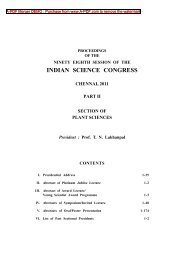sustainable use of biological diversity.pdf - India Environment Portal
sustainable use of biological diversity.pdf - India Environment Portal
sustainable use of biological diversity.pdf - India Environment Portal
Create successful ePaper yourself
Turn your PDF publications into a flip-book with our unique Google optimized e-Paper software.
Sustainable <strong>use</strong> <strong>of</strong> <strong>biological</strong> <strong>diversity</strong> in socio-ecological production landscapes<br />
an effort to increase bio<strong>diversity</strong> conservation, particularly<br />
on private lands, while encouraging <strong>sustainable</strong><br />
rural development. While efforts to pursue<br />
paysage humanisé status in the Estran region are currently<br />
on hold, this active resident-driven process is<br />
an indication <strong>of</strong> the value the communities place on<br />
their special landscapes (Blattel et al. 2008).<br />
3.5 Appleton Farms – An example <strong>of</strong> private<br />
governance by a land trust<br />
Land trusts are crucial actors in the protection<br />
and stewardship <strong>of</strong> landscapes in North America,<br />
particularly in a region like New England (the six<br />
northeastern-most states), where the majority <strong>of</strong><br />
land is privately owned. A land trust is a private nongovernmental<br />
organization created with the aim <strong>of</strong><br />
conserving land, either through direct acquisition<br />
<strong>of</strong> properties and/or through negotiation <strong>of</strong> agreements<br />
with landowners, including legal agreements<br />
(e.g., conservation easements) and other management<br />
agreements (Mitchell 2006). While the land<br />
trust movement originated in New England in the<br />
late nineteenth century, in recent decades the movement<br />
has grown dramatically with the emergence <strong>of</strong><br />
new land trusts throughout the United States and<br />
Canada. New networks such as the Canadian Land<br />
Trust Alliance signal the growing importance <strong>of</strong> the<br />
land trust model in Canada.<br />
Established in 1891, the Trustees <strong>of</strong> Reservations is<br />
the oldest land trust in the world. With a mission<br />
to preserve, for public <strong>use</strong> and enjoyment, properties<br />
<strong>of</strong> exceptional scenic, historic, and ecological value<br />
in Massach<strong>use</strong>tts, it now serves as a steward <strong>of</strong> over<br />
nearly 25,000 acres <strong>of</strong> land throughout the state. The<br />
Trustees <strong>of</strong> Reservations manages over 100 properties<br />
in Massach<strong>use</strong>tts, a diverse array <strong>of</strong> sites protected<br />
for their historic and cultural values, as well<br />
as their natural values (http://www.thetrustees.org/<br />
about-us/our-mission).<br />
An excellent example <strong>of</strong> one <strong>of</strong> its properties is<br />
Appleton Farms (Ipswich, Massach<strong>use</strong>tts), a cultural<br />
landscape sustaining traditional agriculture, including<br />
heritage crops and livestock, as well as, grasslands,<br />
woodlands and wetlands. It claims the mantle<br />
<strong>of</strong> being America’s “oldest continuously operating<br />
farm” (dating back to 1636), and a portion <strong>of</strong> the<br />
property is currently under cultivation, with products<br />
marketed locally through an active, extremely<br />
popular Community-Supported Agriculture (CSA)<br />
program.<br />
The Appleton Farms protected landscape plays an<br />
important role in bio<strong>diversity</strong> conservation, due to<br />
its <strong>diversity</strong> <strong>of</strong> habitats, along with its crucial role in<br />
making linkages in the broader landscape to other<br />
adjacent forested and agricultural land. Its grasslands<br />
provide habitat for one <strong>of</strong> New England’s largest<br />
populations <strong>of</strong> bobolinks and meadowlarks, and<br />
its wetlands are important for migrating marsh birds<br />
as well as reptiles and amphibians, including certain<br />
rare species. Resident mammals include deer, fox,<br />
coyote, mink and fishers, and the property is important<br />
for migratory birds including several raptor species<br />
(http://www.appletonfarms.org).<br />
Appleton Farms also <strong>of</strong>fers a good example <strong>of</strong> the<br />
many ways a Satoyama-like landscape can contribute<br />
to “human well-being.” In addition to its role in<br />
nature conservation and environmental services, it<br />
<strong>of</strong>fers many social benefits to the local community,<br />
including place-based education programs, recreational<br />
opportunities (such as trails for walking and<br />
winter sports), and its Community-Supported Agriculture<br />
program.<br />
3.6. Indigenous and Community-Conserved Areas<br />
(ICCAs)<br />
Looking to Mexico, one can find a wide array <strong>of</strong><br />
examples <strong>of</strong> Indigenous and Community Conserved<br />
Areas (ICCAs). Much progress is being made in recognizing<br />
these areas, through recent amendments<br />
to the national legislation to reinforce the status <strong>of</strong><br />
© R. Cheek / Courtesy <strong>of</strong> The Trustees <strong>of</strong> Reservations<br />
© R. Cheek / Courtesy <strong>of</strong> The Trustees <strong>of</strong> Reservations<br />
appleton farms in Massach<strong>use</strong>tts, a property <strong>of</strong> the trustees <strong>of</strong> reservations, is an example <strong>of</strong> a cultural landscape being<br />
managed by a land trust.<br />
42
















